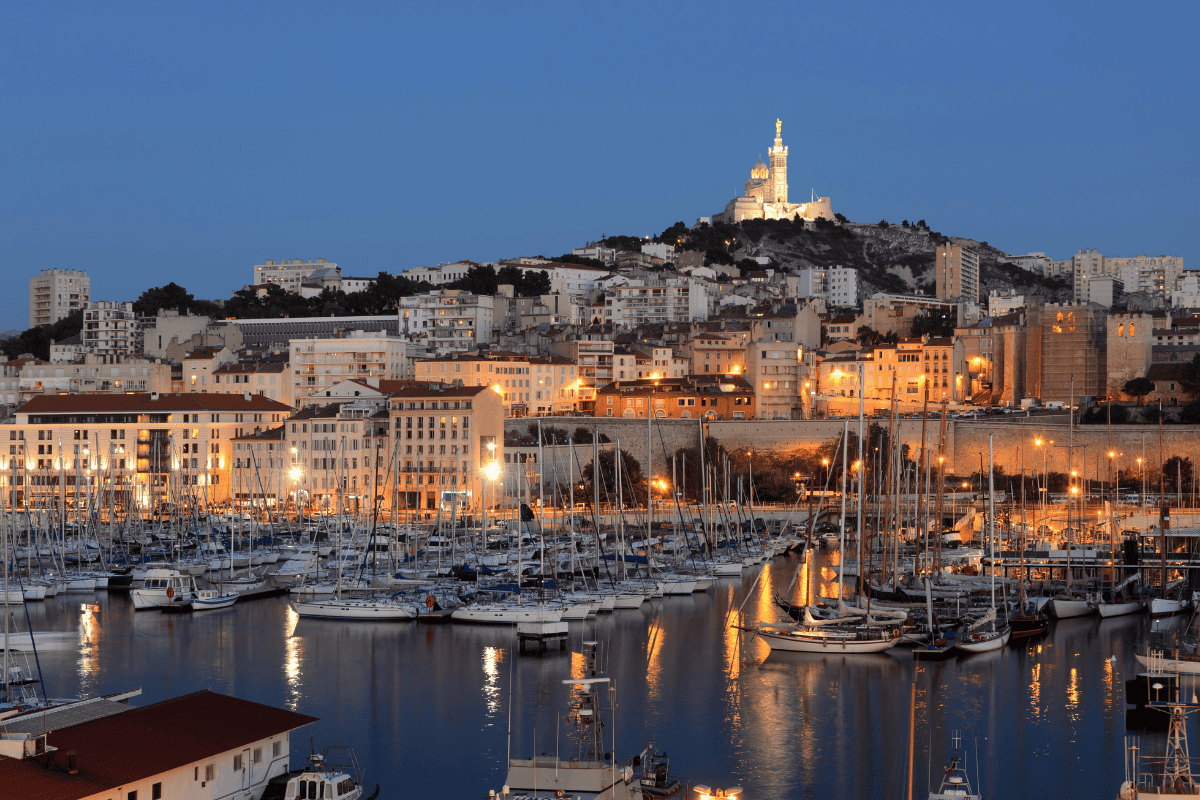Marseille Itinerary for History Lovers + Nerdy Travelers
Marseille is one of the most overlooked cities in France — and also one of the most historically important. If you’re planning a Marseille itinerary that goes deeper than the basics, this guide was made for you.
Founded by the Greeks in 600 BCE, it’s the oldest city in the country, a gateway to the Mediterranean, and a living record of France’s multicultural past. And yet… most travel guides treat it like an afterthought.
If you’re the kind of traveler who wants to go deeper — beyond picture-perfect villages and into the heart of a city shaped by empire, religion, resistance, and radical design — Marseille is for you.
This guide is not your average list of top things to do. It’s curated especially for nerdy travelers: the museum lovers, history buffs, and cultural deep-divers who crave stories behind the architecture, and context behind the chaos.
When I visited in 2024, Marseille instantly struck me as the kind of place that doesn’t just show you the past — it makes you feel like you’ve stepped through time.
One moment you’re standing at the edge of a Greek-founded port, the next you’re inside a modernist concrete giant that shaped architectural history. It’s immersive, gritty, layered — and completely unforgettable.
Affiliate links are included where helpful (skip-the-line tickets, guided tours, museum passes), so you can get straight to the good stuff. I may earn a commission at no extra cost to you. Thank you for supporting my travel content and helping me bring you more UNESCO-focused content!
Explore the Vieux Port — The Beating Heart of Ancient Marseille
Marseille began at the water’s edge — and the Vieux Port (Old Port) is where it all started. This natural harbor was the landing site for Greek settlers over 2,600 years ago, when they founded the city of Massalia in 600 BC.
Today, it’s still the soul of the city — a place where fishing boats bob alongside pleasure yachts, teenagers dangle their legs over the edge, and locals argue loudly in French while buying their dinner from the morning fish market.
For history lovers, this isn’t just a picturesque marina. It’s a continuously active port that’s been in use since ancient times, shaped by Greek traders, Roman generals, medieval merchants, and 20th-century warships.
You can feel the weight of that history in the air — and see traces of it if you look closely at the surrounding architecture and fortifications.
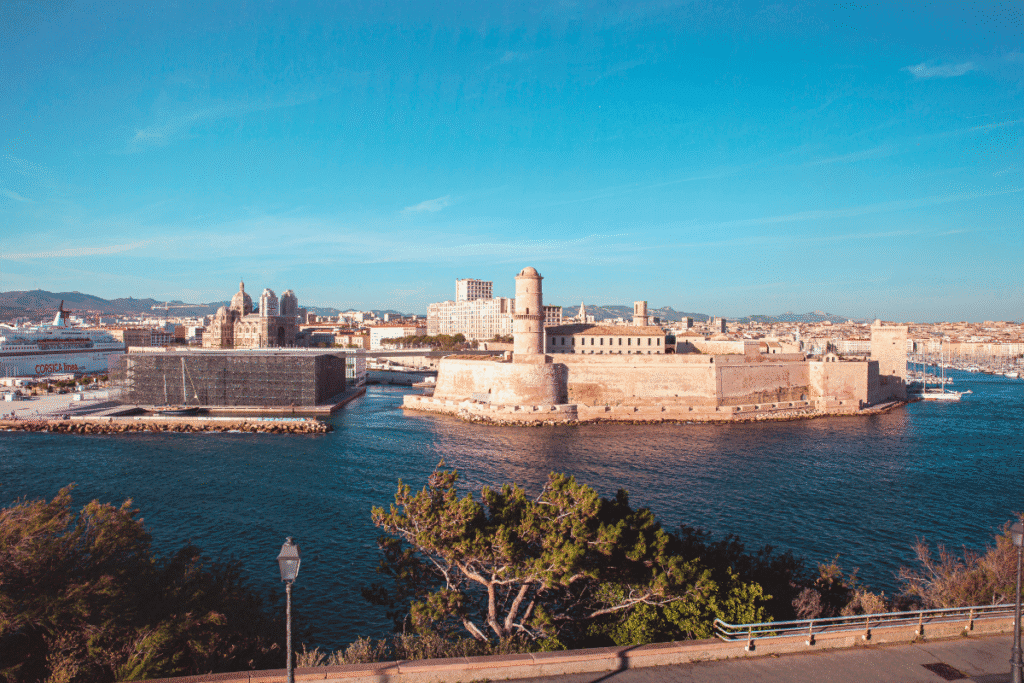
What to Do at the Vieux Port
- Arrive early in the morning to see fishermen selling their catch directly from boats
- Grab a coffee or a pied-noir pastry and do some people-watching from the shaded arcades
- Visit Fort Saint-Nicolas and Fort Saint-Jean, the old defenses that frame the harbor
- Walk across the footbridge to MUCEM (coming up next in this post)
- Catch a boat to Château d’If — the famous island prison from The Count of Monte Cristo
- Even if you don’t “do” anything, this is the kind of place where just being there is the experience. It’s living history with a salty breeze and a killer sunset.
👉 Want to explore Marseille’s coastline by boat?
While most harbor cruises leave from the Vieux Port, many head toward the stunning Calanques — a series of limestone inlets and turquoise coves just outside the city.
Check out my full guide to the best day trips from Marseille for how to plan it right. (link when ready)
Climb to Notre-Dame de la Garde for Epic Views and Maritime History
Perched on the highest natural point in Marseille, Notre-Dame de la Garde isn’t just a pretty church with a view — it’s a symbol of protection, pilgrimage, and the city’s deep connection to the sea. Known locally as la Bonne Mère (“the Good Mother”), this 19th-century basilica has watched over Marseille’s sailors, fishermen, and families for generations.
Built on the site of an earlier chapel (and a military fort before that), the basilica blends Romanesque and Byzantine styles, with its iconic striped stonework and a gilded Madonna towering at 37 feet (11.2 meters) high. But as grand as it looks from a distance, it’s what’s inside that makes it such a powerful stop for history nerds.
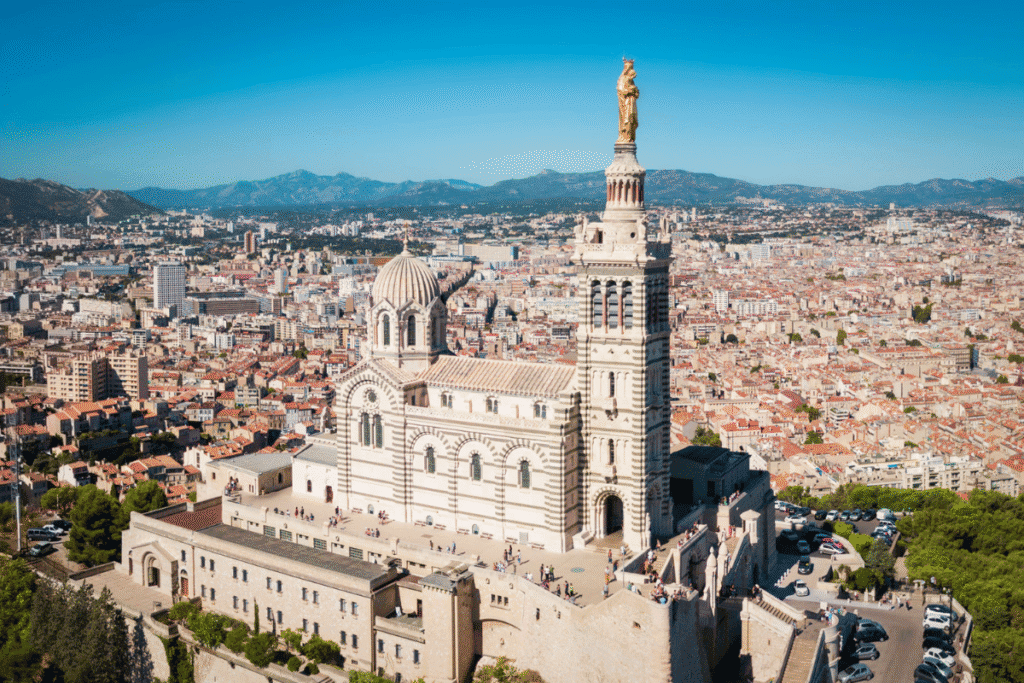
Why Nerdy Travelers Will Love It
- The interior features nautical votive offerings — tiny model ships, paintings of sea rescues, and heartfelt tributes from sailors who believed the Virgin Mary brought them safely home
- The crypt and chapel hold layers of both religious and military significance
- You can still see remains of the original fort, used to defend Marseille’s coastline
- And of course, there’s the view. Sitting at an elevation of 532 feet (162 meters) above sea level, the panorama of Marseille is unmatched — you can spot the Vieux Port, Château d’If, the Cité Radieuse, and the sprawl of the modern city all at once.
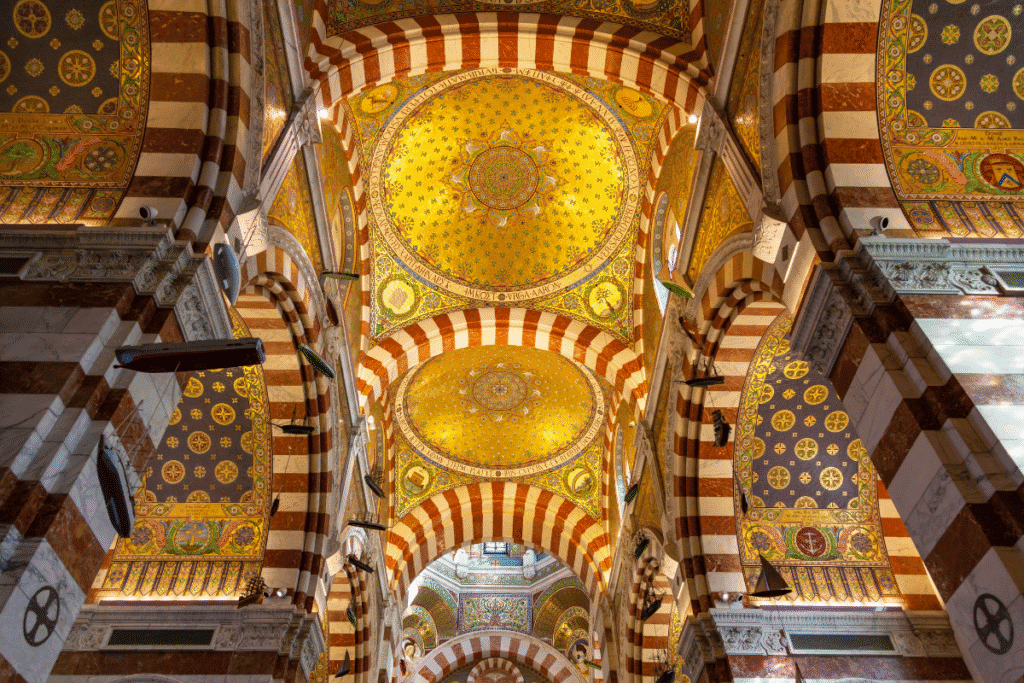
Getting There:
You’ve got two options — and both come with a story
- Hiking up takes about 30 minutes, but fair warning: it’s steep. We had to stop for multiple breaks along the way (and we’re not out of shape!). There are switchbacks and staircases, but don’t underestimate the sun or incline.
- Bus 60 leaves regularly from the Vieux Port and drops you right at the top. If you’re going in summer or mid-day, this might be the wiser choice.
👉 Want the full backstory while you explore?
Book a guided walking tour that includes Notre-Dame de la Garde and let someone else narrate the history and pace the climb.
Visit the Museum of Civilizations of Europe and the Mediterranean (MUCEM)
Even if you’re not usually a “museum person,” MUCEM might convert you. Opened in 2013 as part of Marseille’s reign as the European Capital of Culture, the Museum of Civilizations of Europe and the Mediterranean sits at the edge of the sea — literally. Its striking modern architecture rises like a geometric shadow beside the 17th-century Fort Saint-Jean, blending the old and the new in a way that perfectly mirrors Marseille’s story.
For nerdy travelers, this place is a goldmine. The museum doesn’t just focus on France — it connects Marseille to the wider Mediterranean world through exhibitions on religion, trade, migration, architecture, and resistance. It’s ambitious in scope and surprisingly human in its storytelling.
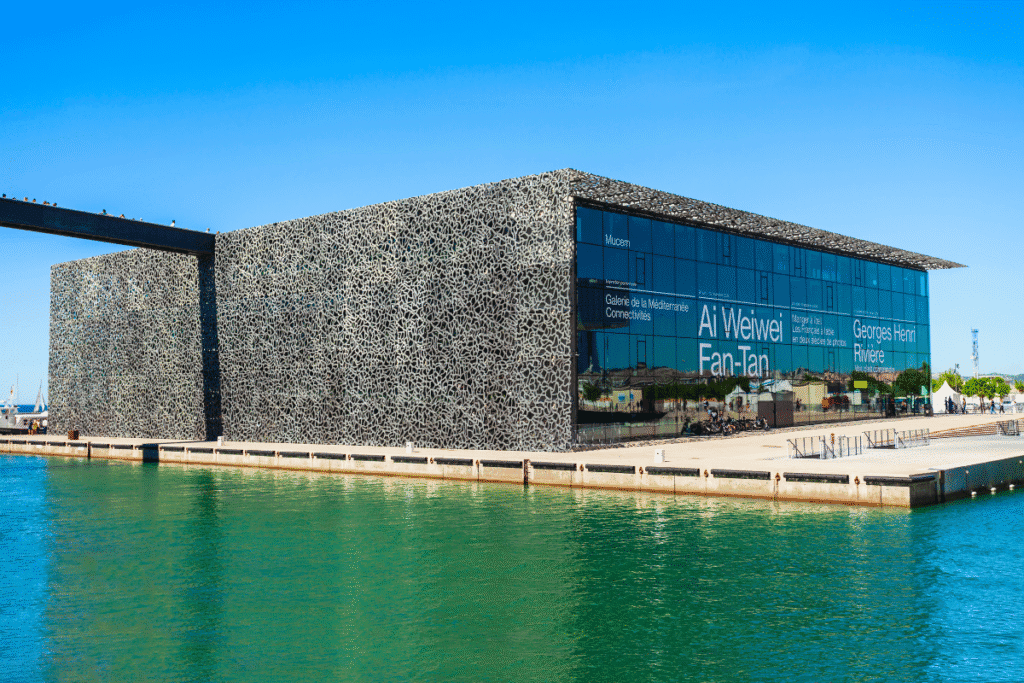
Why You’ll Love It
- The permanent collections explore themes like borders, belief systems, and the movement of people — all topics Marseille has embodied for centuries
- The temporary exhibits are often fantastic and deeply researched (check the website ahead of time)
- The rooftop terrace gives you stunning views of the sea, the port, and the basilica — with way fewer crowds than Notre-Dame de la Garde
- The museum is connected to Fort Saint-Jean via a dramatic pedestrian bridge, which alone is worth the visit. Inside the fort, you’ll find lush gardens, open-air walkways, and layers of military architecture dating back to the 1600s.
Plan Your Visit
- MUCEM is large — budget at least 2–3 hours
- It’s fully accessible and air-conditioned (BLESS!)
- Entry to Fort Saint-Jean is free, but the museum exhibitions require a ticket
👉 Save time and book skip-the-line MUCEM tickets here — especially during summer or cruise ship days
Wander the Le Panier Neighborhood — Marseille’s Oldest District
Just a short walk uphill from the Vieux Port, Le Panier is the kind of neighborhood where you’ll want to put the map away and just get lost on purpose. This is the oldest part of Marseille — settled by the Greeks, reshaped by Romans, and continuously lived in ever since.
The name Le Panier literally means “the basket,” and its tangled web of narrow streets feels like one: filled with colorful buildings, painted shutters, open balconies, and unexpected turns.
It’s not a museum. It’s a neighborhood. And that’s exactly why it’s so compelling.
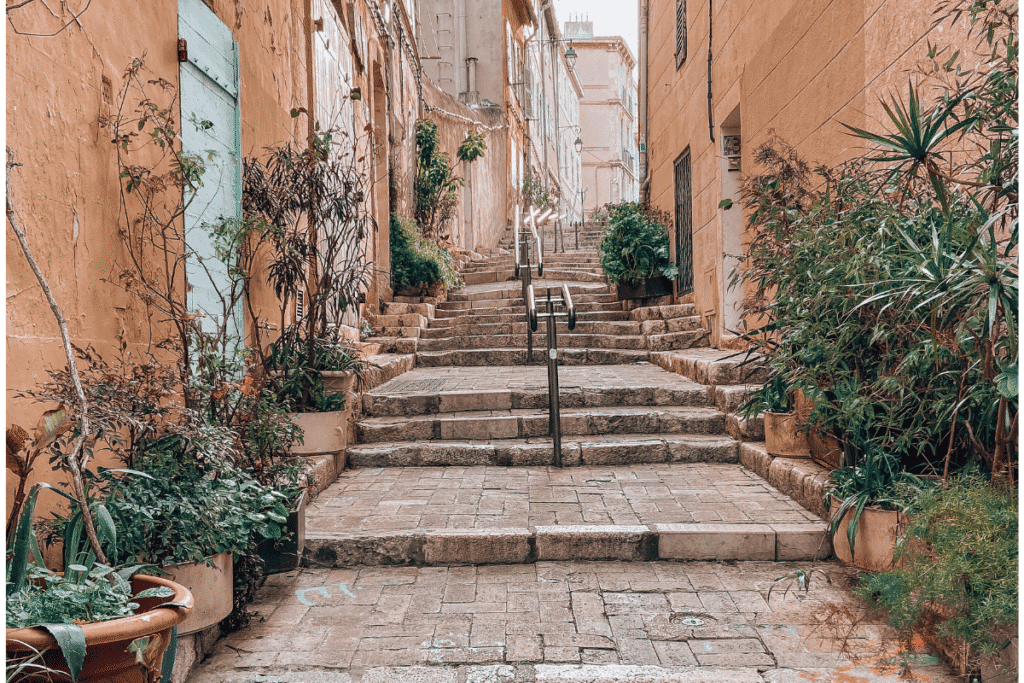
Today, Le Panier is known for its street art, artisan shops, and bohemian vibe, but beneath all that paint are centuries of layered history — from religious enclaves to revolutionary meeting spots.
What Nerd Travelers Should Look For
- The remains of Roman-era street plans are still visible in the layout (look for stones underfoot and curving alleyways)
- The Vieille Charité, a 17th-century almshouse turned cultural center, sits at the heart of the district
- Local workshops and galleries offer everything from handmade soap to Provençal ceramics
Nerd Alert: During World War II, large parts of Le Panier were razed by Nazi forces under the guise of “urban renewal.” The area has since rebuilt itself — preserving its identity, scars and all.
Insider Tip:
Wear real shoes. These are cobbled, uneven streets. Bring your camera, sure — but more importantly, bring your curiosity.
👉 Take a deeper dive into the neighborhood with a Le Panier history and street art walking tour — it’s a great way to get context while discovering spots you’d otherwise miss.
Château d’If — The Count of Monte Cristo’s Legendary Prison Island
Just off the coast of Marseille lies a small, rocky island with a fortress that has captured imaginations for centuries — Château d’If. Originally built in the 16th century as a defensive stronghold under King François I, it soon became a state prison. But it wasn’t until Alexandre Dumas set part of The Count of Monte Cristo here that it entered pop culture history.
In the novel, the wrongly imprisoned Edmond Dantès is held at Château d’If before making his daring escape. Though the book is fictional, the prison is real, and walking through its echoing stone chambers feels like stepping inside the pages.
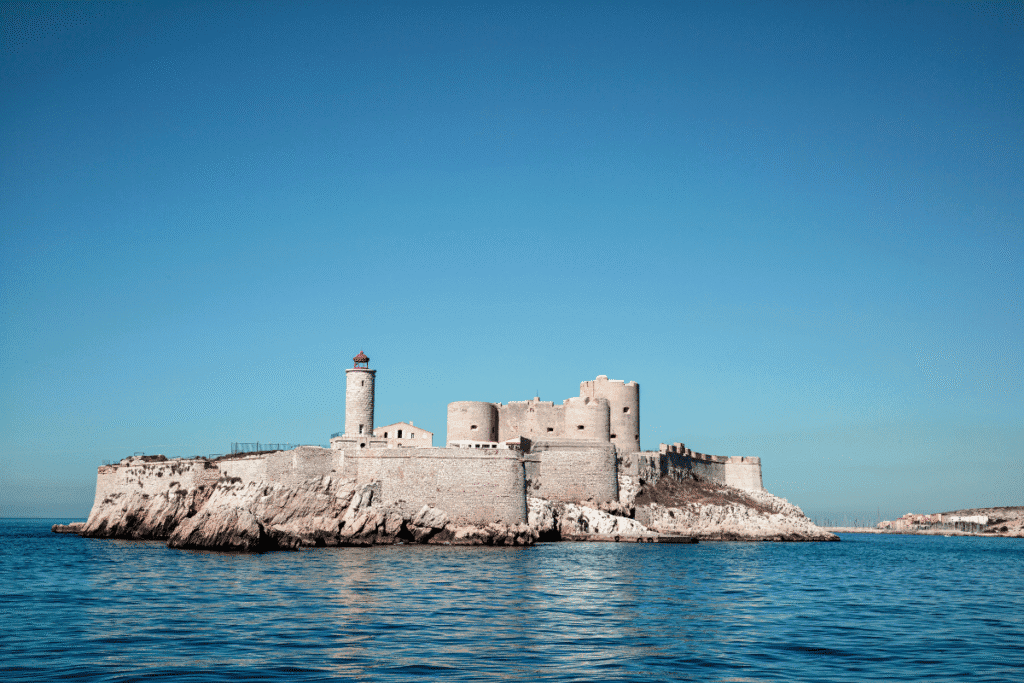
Why History + Lit Nerds Will Love It
- The fortress was used to imprison political dissidents, Protestants, and anyone the state deemed “troublesome”
- You can explore the actual prison cells, including one marked as Dantès’ (a tribute to the novel)
- The views of Marseille from the island are incredible — and eerily isolating, just as Dumas described
Nerd Alert: Dumas himself visited the island and helped popularize its mythos — blurring the lines between fiction and history in a way only 19th-century authors could.
Visiting Tips:
- Boats depart from the Vieux Port regularly, weather permitting (rough seas = no service)
- The crossing takes about 20 minutes
- There’s a small entrance fee to the fortress once you arrive, in addition to the ferry ticket
- Allow 2–3 hours round-trip
👉 Book your Château d’If entry tickets here — especially helpful in peak season when ferries fill up. If you purchase a Marseille City Pass, you can book a ferry ride and entry ticket combination.
Le Corbusier’s Cité Radieuse — Brutalist Beauty in a UNESCO Wrapper
It’s big. It’s blocky. And it’s one of the most influential buildings of the 20th century. If you’re an architecture nerd, design enthusiast, or just someone who appreciates a little concrete controversy, Cité Radieuse is a must-visit in Marseille.
Designed by Le Corbusier and completed in 1952, this housing complex wasn’t just a building — it was a manifesto. Officially called the Unité d’Habitation (which translates to “Housing Unit” or “Housing Block”), it was part of Corbusier’s post-WWII vision for modern urban living: a “vertical city” where residents could live, shop, exercise, and connect with neighbors — all without leaving the structure.
Today, it’s a UNESCO World Heritage Site and still functions as a residential building, which makes visiting it feel like stepping inside a living architectural experiment.
What to See at Cité Radieuse:
- The open rooftop terrace, which includes a sculptural playground, a running track, and wild views over Marseille
- The brutalist details — raw concrete, modular layout, and pilotis (stilts) that lift the structure off the ground
- The onsite design hotel, art gallery, bookstore, and restaurant — open to visitors even if you don’t stay there
Nerd Alert: This was the first of several “Unité” buildings across Europe, and it directly influenced modern architecture for decades. Love it or hate it, its legacy is massive.
Important Note:
When I visited during the Olympics, it was very difficult to get access. The rooftop and some common areas are only open during specific hours or with guided tours. Call ahead or book online if you’re visiting during a busy season.
👉 Reserve a spot on a modern architecture tour of Marseille that includes Cité Radieuse — it’s the easiest way to guarantee access and get expert commentary.
Bonus Nerd-Worthy Stops You Should Not Miss
If you’ve already hit the “big name” attractions but still have time (or if you’re the type to skip the big names in favor of hidden history), these next few spots are for you. Marseille is packed with places that tell quiet but powerful stories — from medieval abbeys to soap factories and repurposed charitable institutions.
Savon de Marseille Museum
Marseille’s iconic soap has been around since the 1600s, and this museum makes the case that it deserves just as much cultural respect as its churches and forts.
You’ll learn how olive oil, seawater, and lye became the base of a globally traded product — and why genuine Savon de Marseille is still made using traditional cauldrons today. Exhibits include vintage advertisements, soap molds, and even machines from old factories.
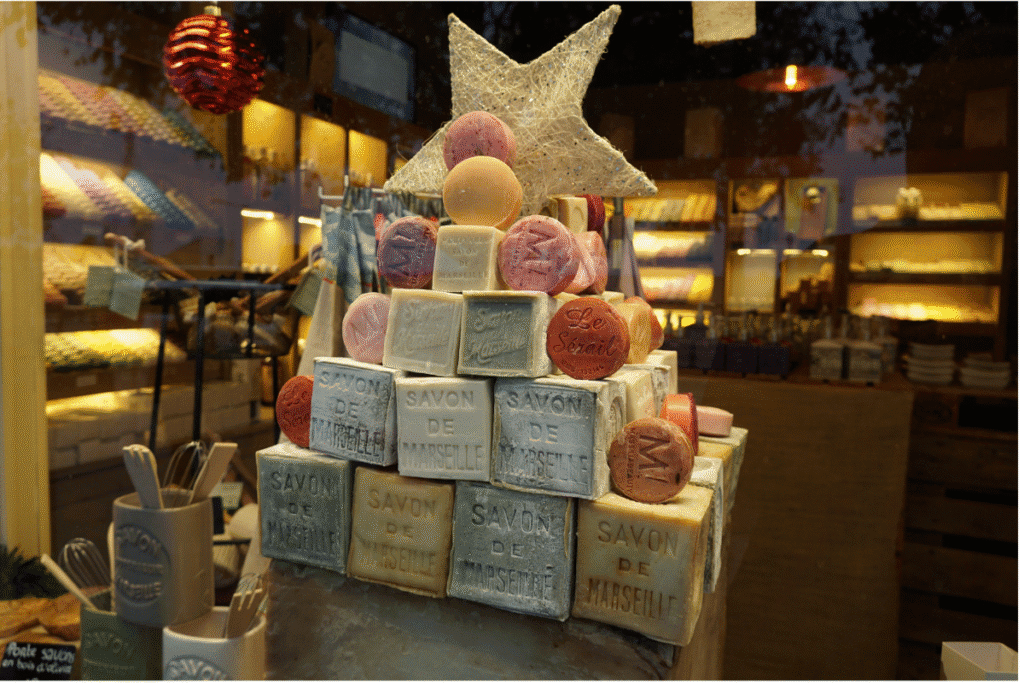
Nerd Alert: At its peak, Marseille had over 100 soap factories — making it a critical part of both the French economy and hygiene revolution.
👉 Book a Savon Museum visit or hands-on soap-making workshop if you want to take home a souvenir with historical heft.
Vieille Charité
Located in the heart of Le Panier, this 17th-century baroque masterpiece was originally an almshouse designed to shelter Marseille’s poor. Today, it’s a cultural and research complex housing several museums and temporary exhibitions — and it’s easily one of the most beautiful courtyards in the city.
Designed by Pierre Puget, the same architect behind several Versailles elements, the central domed chapel is surrounded by three levels of arched galleries — perfect for photo ops and pondering.
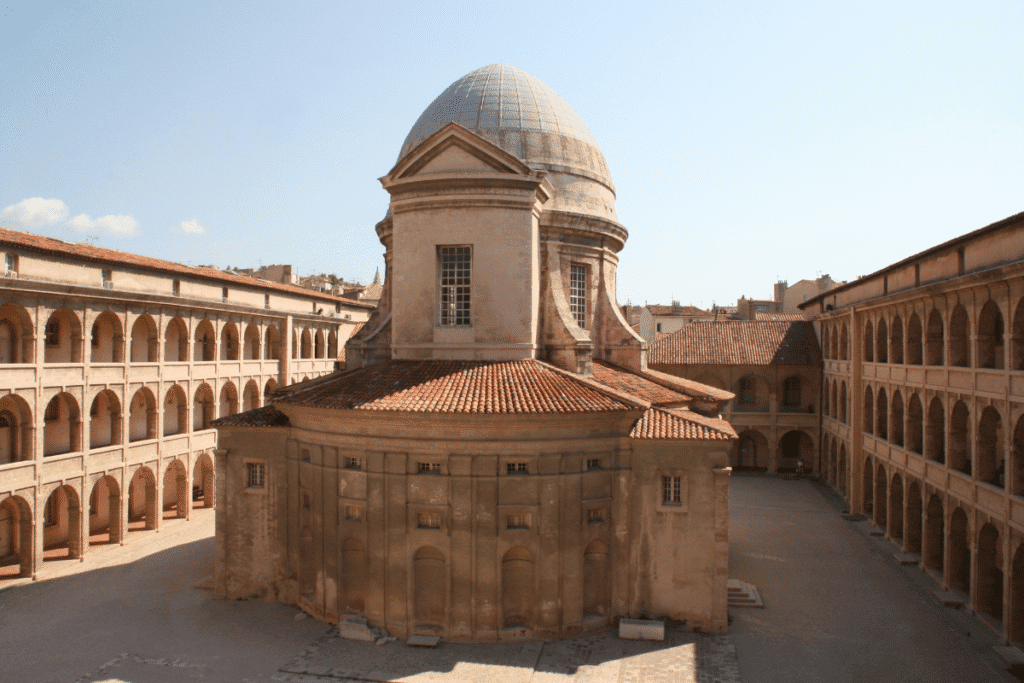
Exhibits rotate but often include anthropology, archaeology, and Mediterranean cultural themes.
👉 Entry is free to the courtyard and to the permanent collections in the museums. Temporary exhibitions do require paid access.
Abbaye Saint-Victor
This ancient abbey predates Notre-Dame de la Garde by centuries and was one of the most important religious centers in Provence during the Middle Ages. Its crypts hold relics, sarcophagi, and a heavy sense of sacred silence.
Originally founded in the 5th century, the abbey has been destroyed, rebuilt, and repurposed across the ages. It’s especially significant for early Christian historians and anyone interested in monastic life.
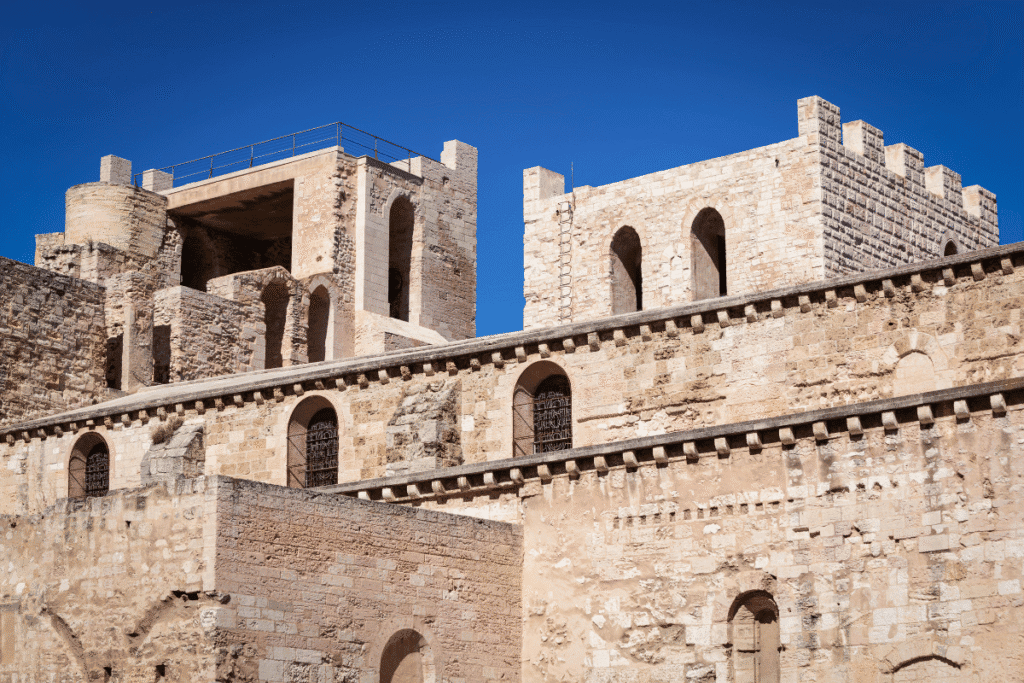
Nerd Alert: The abbey’s oldest sections were carved directly into the rock — and still feature pre-Romanesque architecture.
👉 Join a guided religious heritage tour of Marseille to get expert insight on Saint-Victor and other spiritual landmarks
JFK Walkway & What Might Be the World’s Longest Bench
Running along Marseille’s southern coastline, the Promenade Président John F. Kennedy (locals just call it the “JFK Walkway”) is one of the city’s most scenic stretches of seaside path. It’s great for sunrise jogs, sunset strolls, or just sitting with a coffee and watching waves crash against the rocks.
But here’s where it gets weirdly nerdy: the promenade is home to what may be the longest bench in the world — a continuous stretch of curved concrete seating that runs roughly 1,600 feet (nearly half a kilometer). It’s unofficial, of course, but that hasn’t stopped locals from claiming the title with pride.
Whether or not it’s technically the longest, it’s certainly one of the most unexpected urban design features in France — and a quirky place to rest between walks.
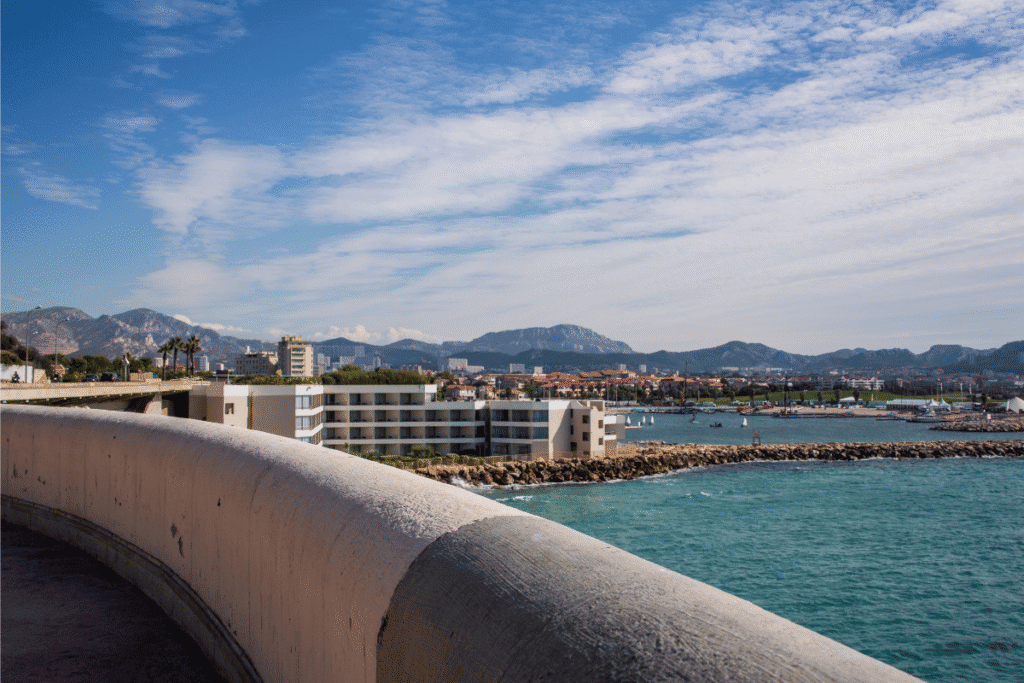
Nerd Alert: The bench is so long that it subtly curves with the earth’s horizon — and during the Olympics, it became a favorite hangout spot for international fans and locals alike.
👉 No ticket needed here — just bring good shoes and maybe a snack for bench-sitting.
What to Skip (and Why)
Marseille is full of layered, fascinating sites — but like any major destination, there are a few experiences that feel more style than substance. If your time is limited (and let’s be honest, it usually is), here are a few things you can safely skip or save for a future trip.
Generic Harbor Cruises Without Commentary
Yes, the views are great. But many of the basic boat rides you’ll find around the Vieux Port are light on history and heavy on Instagram moments. If you’re going to explore by water (and you should!), opt for a cruise with a guide or narration so you can actually understand what you’re seeing.
Midday Outdoor Treks in Peak Summer
This isn’t a specific site, but it’s worth saying: don’t plan your longest walks at high noon in July or August. The sun is intense, shade is scarce, and even seasoned travelers (hi, it’s me) have found themselves drained by Marseille’s dry coastal heat. Prioritize early mornings or late afternoons for hikes, especially to Notre-Dame de la Garde or the seaside corniche.
Overpriced “Provençal” Souvenir Shops
While Marseille has a strong local identity, many souvenir shops in the port area push mass-produced Provençal goods that feel more like a postcard from Avignon than from Marseille. For more authentic items, shop in Le Panier, visit the Savon Museum gift shop, or look for products made in the city proper (Savon de Marseille, ceramics, or Marseille-based designers).
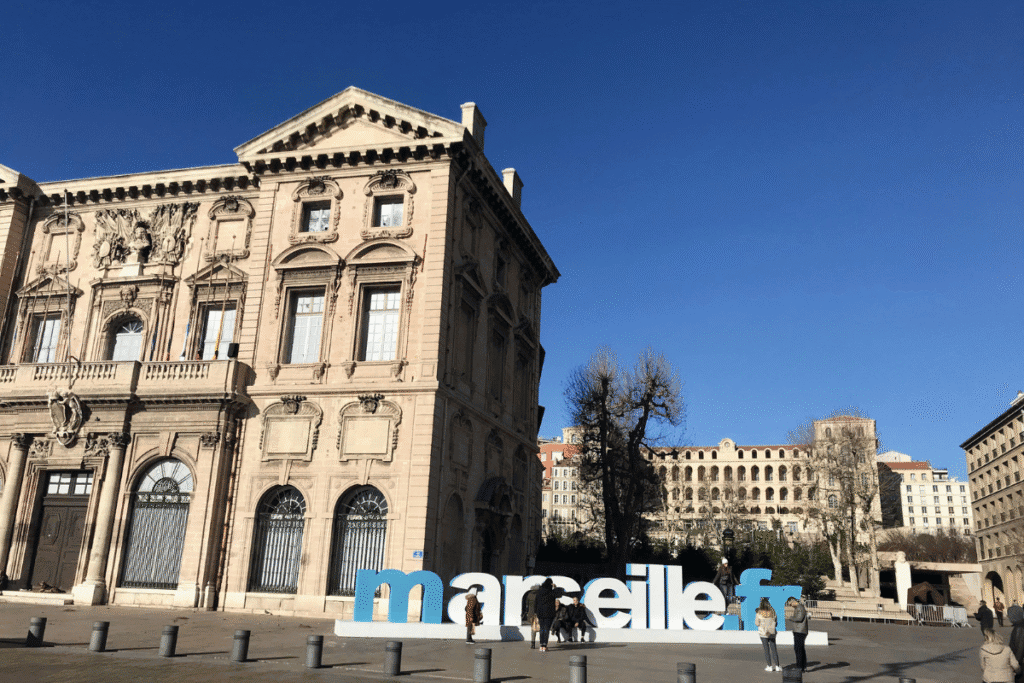
Ready to Explore Marseille? Let’s Build Your Itinerary
Whether you’re planning your first visit or coming back for a deeper dive, Marseille rewards travelers who are curious, open-minded, and ready to learn through experience.
It’s not a checklist city. It’s a city that reveals itself in layers — through ancient foundations, immigrant stories, surprising museums, and chaotic-but-beautiful urban moments.
And if you’re the kind of traveler who wants to make the most of it — without spending 20+ hours researching museum hours and deciphering bus maps — I’ve got options for you:
Choose Your Planning Style
Grab the Ready-Made Marseille Itinerary
Perfect for independent travelers who want a plug-and-play plan curated by someone who has actually been there. Includes a 7-day historical and cultural itinerary with walking routes, metro tips, food recs, and nerdy site notes.
👉 Get the Marseille itinerary here (digital download)
Or Book Custom Travel Planning with Me
Want to combine Marseille with Arles, Lyon, or Provence? Need help figuring out how long to stay, where to base yourself, or which museums are worth it? I offer 1:1 travel planning to help nerdy travelers go deeper, not just further.
👉 Click here to contact me directly by filling out this form.

